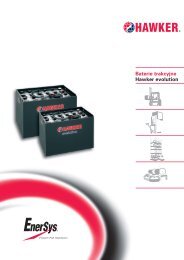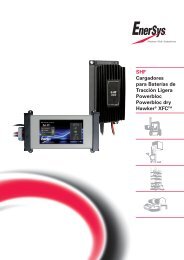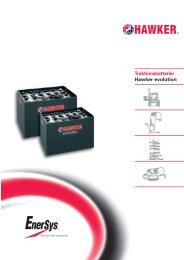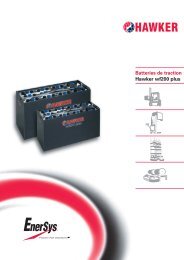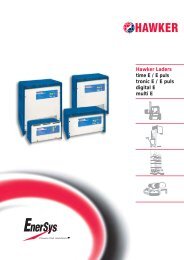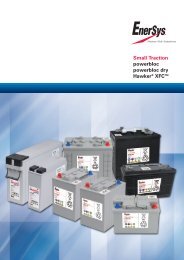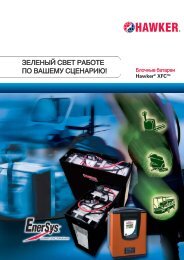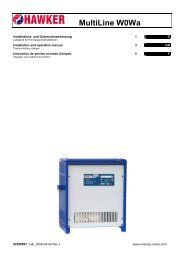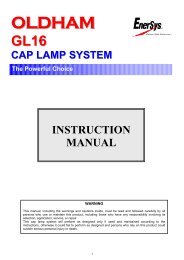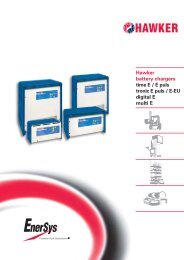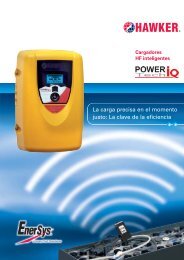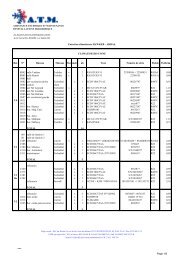16533 GA Lifespeed IQ mehrspr.:GA A5 - EnerSys-Hawker
16533 GA Lifespeed IQ mehrspr.:GA A5 - EnerSys-Hawker
16533 GA Lifespeed IQ mehrspr.:GA A5 - EnerSys-Hawker
Create successful ePaper yourself
Turn your PDF publications into a flip-book with our unique Google optimized e-Paper software.
Safety and use instructions LifeSpeed <strong>IQ</strong> TM - 3-phase chargers<br />
SAFETY INSTRUCTIONS<br />
GOALS OF THIS MANUAL<br />
This manual is aimed at any authorized personnel wanting<br />
to use a 3-phase LifeSpeed <strong>IQ</strong> TM charger to recharge lead<br />
acid motive power batteries (vented, <strong>Hawker</strong> XFC TM , Gel or<br />
Water Less ® /Water Less ® 20 ranges)<br />
This manual contains information on:<br />
Charger functionality.<br />
Use and setting of charger parameters.<br />
Technical specifications of the LifeSpeed <strong>IQ</strong> chargers.<br />
<strong>EnerSys</strong> ® intends to provide clear and simple information<br />
in this manual, and assumes no responsibility for misunderstanding<br />
or improper interpretation of the information.<br />
The owner of the equipment is required to preserve this<br />
manual during the life of the equipment and to transfer said<br />
manual to any subsequent purchaser.<br />
WARRANTY<br />
Warranty is offered by the manufacturer based on local<br />
regulations. Please contact your local distributor for further<br />
information.<br />
RECOMMENDATIONS<br />
Recommendations for safe operation<br />
This manual should be carefully read, prior to using the<br />
equipment, by anyone intending to use the charger.<br />
The LifeSpeed <strong>IQ</strong>:<br />
Must not have its air circulation impaired in any way,<br />
primarily around the air inlet areas.<br />
Dust accumulation must be removed every 12 months.<br />
Must be used within its protection norms, and never<br />
be directly in contact with water.<br />
Must be used only within the temperature range<br />
specified in the technical specifications.<br />
Internal connection torques must be checked once a<br />
year.<br />
Must not be installed on a surface subject to high<br />
vibration levels (proximity of motors, compressors, etc.).<br />
Must not be installed close to the batteries in order to<br />
avoid any gassing that could damage it prematurely.<br />
Must not be installed in arduous environments such as:<br />
Harbour applications (saline environment)<br />
Close to cold stores<br />
External locations with exposure to wind and rain<br />
Operator safety<br />
All proper precautions must be observed when the<br />
equipment is used in areas where accidents are possible.<br />
Ensure proper ventilation when the charger is used with<br />
lead-acid batteries, due to gassing. Never disconnect the<br />
battery during the charging process.<br />
General warnings<br />
Requirements for use:<br />
The equipment must be properly grounded (earthed).<br />
The input voltage must match the charger requirements.<br />
The battery voltage must match the charger’s<br />
capabilities.<br />
The battery capacity is within the charger’s range.<br />
ELECTRICAL SAFETY<br />
Safety regulations and requirements must be observed.<br />
Safety devices installed on the electrical supply to the<br />
chargers must be of the proper type and rating. It is<br />
important to ensure that only fuses of the proper<br />
capacity should be used if they need to be replaced.<br />
ENGLISH<br />
The equipment must be totally disconnected from all power<br />
sources (mains supply and battery) before it can be opened<br />
for inspection or servicing. The battery can only be disconnected<br />
after the charge has been stopped by pushing the<br />
Stop/Start button. Access to the inside of the charger<br />
should be restricted to authorized maintenance personnel.<br />
Please consult a qualified factory representative about any<br />
problems or questions related to the installation of this<br />
unit.<br />
LIMITS OF USE<br />
This charger is designed to be used in a sheltered area.<br />
It is designed exclusively to recharge lead batteries in an<br />
industrial environment.<br />
PRODUCT RECYCLING - DESTRUCTION<br />
When this charger becomes obsolete, it can be recycled<br />
or destroyed by authorized facilities. Local regulations will<br />
prevail and must be followed.<br />
MODIFICATIONS AND IMPROVEMENTS<br />
<strong>EnerSys</strong> reserves the right, at any time, to modify or<br />
improve its products, without any obligation to update<br />
this product or this manual accordingly.<br />
The customer is not permitted to modify the product from<br />
its original design and configuration (e.g. fitting additional<br />
modules).<br />
Any changes made by the customer could affect the<br />
product performance and invalidate the warranty.<br />
RECEIVING - STORAGE<br />
Upon receipt, please inspect visually the exterior of the<br />
charger for any physical damage. If necessary, proceed<br />
within 24 hours with the usual claims procedure with the<br />
transport company.<br />
If the charger is to be stored before use, it should remain<br />
in the original packaging, carefully closed. Store in a clean,<br />
dry area at a moderate temperature (0 °C to +40 °C). If the<br />
equipment is stored at a temperature below 15°C, it must<br />
be gradually (24 hours) restored to operating temperature<br />
before use, to prevent the risk of condensation that could<br />
cause electrical faults and short-circuits.<br />
INFORMATION PLATE<br />
Located on either side of the charger.<br />
EC DECLARATION OF CONFORMITY<br />
<strong>EnerSys</strong> hereby declares that the chargers in the<br />
LifeSpeed <strong>IQ</strong> range covered by this declaration<br />
conform to European Directives:<br />
Directive 2006/95/EC (Low Voltage Directive):<br />
EN60950-1<br />
Directive 2004/108/EC (ElectroMagnetic Compatibility):<br />
EN61000-6-2, EN61000-6-4:<br />
Immunity and emissions limits for industrial electronics<br />
(class A- Industrial Environments)<br />
Directive 2002/95/EC (RoHS)
DESCRIPTION & USE<br />
INTRODUCTION<br />
The LifeSpeed <strong>IQ</strong> TM range of chargers is designed to recharge<br />
24 V, 36 V, 48 V, 72V or 80 V batteries with 3-phase mains<br />
supply. The micro processor-controlled unit automatically<br />
recognises the battery (voltage, capacity, charge level, etc.)<br />
and very effectively analyses its condition for optimum<br />
handling. Several charging profiles are available (vented<br />
lead/acid batteries, <strong>Hawker</strong> ® XFC TM batteries, gel batteries<br />
or Water Less ® /Water Less ® 20 batteries) depending on the<br />
configuration selected by the user. The capability for<br />
desulphation, equalisation and refresh charging is also<br />
included.<br />
EXTERNAL COMPONENTS<br />
Presented below:<br />
Ref. Function<br />
1. Control Panel with LCD display<br />
2. USB port<br />
3. Navigation button<br />
4. Modules<br />
5. Input cable<br />
6. Connectors for options:<br />
Ethernet, Electrovalve, Lifenetwork <strong>IQ</strong><br />
7. Output cables<br />
8. Output cables (dual harness only)<br />
9. Ventilation panels<br />
Figure 1: Principal components of the charger.<br />
CONTROL PANEL<br />
Incorporates LCD Display, USB port and navigation button.<br />
LCD Display<br />
The display is fitted with 5 different colours indicating the<br />
status of the charger:<br />
COLOUR<br />
Dark blue<br />
Light blue<br />
Light blue Orange<br />
Green<br />
Red<br />
1<br />
4<br />
5<br />
8<br />
9<br />
Green Orange<br />
2<br />
3<br />
FUNCTION<br />
Waiting status until battery connected<br />
Battery on charge<br />
Alternating, on charge indicating a pump<br />
defect, overdischarge, thermal fault or<br />
module failure<br />
Battery charged<br />
Charger faults DF1, DF2, DF3, TH,<br />
WRG MOD<br />
Alternating, battery charged with pump<br />
defect, overdischarge or module failure<br />
6<br />
7<br />
Navigation button<br />
Functions of the keys<br />
The keys offer the following general functions:<br />
Key Function<br />
Navigation in the menu.<br />
Start/End of list (Press 2 seconds)<br />
The central button is equipped with<br />
a two-coloured LED Green/Red<br />
(Green: charger is waiting, Red charger<br />
operating)<br />
GREEN/RED Stop or Start of charge<br />
Selection of active menu or validation<br />
of value stored<br />
Cancel the value stored<br />
(Press 2 seconds)<br />
Start an equalisation charge.<br />
Access to a sub-menu.<br />
Access to the menus (press 3 seconds)<br />
Close the window.<br />
UNPACKING<br />
The charger is delivered with the following:<br />
2 m AC mains cable.<br />
3 m DC battery cable.<br />
This technical manual.<br />
MECHANICAL INSTALLATION<br />
The charger is intended to be floor standing and must be<br />
installed in the vertical orientation. The distance between<br />
2 adjacent chargers should be at least 0.3 m.<br />
See paragraph Recommendations and avoid areas where<br />
the chargers may be splashed with water, or saline<br />
environments.<br />
ELECTRICAL CONNECTIONS<br />
3-phase input<br />
Connection to the mains supply is 400V AC 3-phase and<br />
must be connected using a suitable plug and adequately<br />
sized circuit breaker (not included). Current requirements in<br />
Amps are indicated on the charger information plate.<br />
Battery output<br />
It is essential to ensure correct polarity. However, reversed<br />
polarity will result in blowing the output fuse, inability to<br />
charge and the fault code DF2 will be displayed. See Fault<br />
Codes.<br />
Connection to the battery should be done using the cables<br />
supplied:<br />
RED cable: battery POSITIVE.<br />
BLACK cable: battery NE<strong>GA</strong>TIVE.<br />
FACTORY SETUP<br />
The charger is delivered with a factory setup as follows:<br />
Profile: As ordered<br />
Output DC cable length: 3 m<br />
Configuration: As ordered<br />
Automatic equalisation: No<br />
Delayed start enabled: No
MODULES MANAGEMENT<br />
There are two types of the modules: 24/36/48V and<br />
72/80V.<br />
It is not allowed to mix both models in a single system.<br />
The modules are plug and play: if the user needs to replace<br />
a module, he just needs to plug the new module into the<br />
cabinet and the system will operate. It is obligatory to<br />
follow safety rules and disconnect the system from AC<br />
and DC sides.<br />
The module management system ensures optimization of the<br />
electrical efficiency & performance of the product.<br />
If one module fails then the system keeps on charging in<br />
a reduced power mode. It allows the battery to be charged<br />
even in the case of module failure.<br />
There are 3 status LED's on the modules:<br />
Red: OFF - normal status / ON - internal module fault<br />
Yellow: OFF - absence of AC supply / ON - normal<br />
status when AC supply present<br />
Green: OFF - module OFF / ON - module ON<br />
(in function - charging)<br />
Red<br />
Yellow<br />
Green<br />
Location of the wrong module in the system (here 3rd<br />
module from the right side on a 6-slot cabinet)<br />
CHARGING THE BATTERY<br />
It is now assumed that the charger has been properly set up.<br />
Charging can only begin with a battery of the proper type,<br />
capacity and voltage connected to the charger.<br />
Off-charge display<br />
With the charger in waiting mode, the display shows<br />
information concerning the charger (top and bottom lines):<br />
1. Charger type (Battery voltage + current).<br />
2. Last selected charging profile.<br />
3. Software version.<br />
4. Waiting indication.<br />
5. Date and time of the charge.<br />
6. Set up battery operating temperature.<br />
Alternating battery temperature/capacity if the ‘manual’<br />
capacity mode is selected.<br />
WAIT<br />
010<br />
Starting the charge<br />
1. If Autostart is On (default ON), the charge starts automatically<br />
when the battery is connected to the charger.<br />
To stop the charge, press the central button .<br />
If Autostart is OFF the charge will start only if the<br />
central button is pressed. To stop the charge, press the<br />
central button .<br />
The display shows information relative to the connected<br />
battery and counts down the time remaining until the<br />
effective charge begins.<br />
Ref. Without Wi-<strong>IQ</strong> ® With Wi-<strong>IQ</strong><br />
1. Charger status (CHARGE, AVAIL, DEFAULT, EQUAL..),<br />
possible pump fault or DF4.<br />
2. Alternating display of battery voltage, voltage per<br />
cell, Ah restored, charging time, remaining charging<br />
time, percentage of battery charge.<br />
3. Set up operating battery Battery temperature and<br />
T°C, and battery capa- capacity given by the<br />
city if manual mode set Wi-<strong>IQ</strong> (*).<br />
4. Charging current<br />
5. Programmed charging Detected charging<br />
profile. profile (*).<br />
6. Various information can be displayed: equalisation<br />
symbol required at the end of charge, USB<br />
connection symbol, Wi-<strong>IQ</strong> link symbol, possible<br />
battery default DF4. See more under messages and<br />
fault codes chapter.<br />
7. Empty line. Alternating, detected serial<br />
number, as information is<br />
received and alarms if<br />
present. See § Fault codes.<br />
(*) as information is received.<br />
012<br />
As soon as the countdown time has elapsed, the display<br />
shows the information relative to the charge.<br />
To induce the start of the charge if the delayed charge has<br />
been programmed:<br />
1. Connect the battery<br />
2. Press the central button to stop the charger.<br />
3. Press and hold the central button for 3 seconds.<br />
Release.<br />
Defaults DF1, DF2, DF3 and TH inhibit the charge. Refer to<br />
section Fault codes.<br />
End of charge without equalisation<br />
1. The backlight of the screen becomes green at the end of<br />
a correct charge and the indication AVAIL is displayed.<br />
Possible alternating display between DF5 default and<br />
pump default and DF4 (ref.1). The displays shows<br />
alternately: (ref. 2):<br />
charging time achieved<br />
number of Ah restored<br />
If the battery remains connected, and in order to<br />
maintain it in a fully charged condition, refresh charges<br />
followed by equalisation charges will be automatically<br />
initiated according to the battery technology.
2. If an equalisation charge has been programmed (vented<br />
battery), it will start automatically. Alternatively, an<br />
equalisation charge can be triggered manually; go to<br />
section End of charge with equalisation.<br />
3. Press the central button or disconnect the battery that is<br />
now ready for use.<br />
End of charge with equalisation<br />
Equalisation only applies to vented batteries. Start can be<br />
manual or automatic.<br />
Manual start<br />
1. At the end of charge (green display light on), press<br />
the key .<br />
The start of the equalisation charge is indicated by the<br />
message EQUAL. During the equalisation charge, the<br />
charger displays the current (ref 4) and alternating, the<br />
battery voltage, voltage per cell, remaining time (ref 2).<br />
2. The battery will be available as soon as the screen<br />
becomes green.<br />
Automatic start<br />
If the equalisation charge has been programmed<br />
(Configuration/Equalisation menu), the equalisation charge<br />
is initiated automatically.<br />
If the battery remains connected, and in order to maintain it<br />
in a fully charged condition, refresh charges followed by an<br />
equalisation charge will be automatically initiated according<br />
to the battery technology. Similar indications to those<br />
displayed in manual start (see above) are displayed.
MESSAGES AND FAULT CODES<br />
Fault<br />
DF1*<br />
DF2*<br />
DF3*<br />
DF4<br />
DF5<br />
DF PUMP<br />
TH*<br />
STOP*<br />
Cause<br />
Charger or mains<br />
supply problem.<br />
Output default.<br />
Wrong battery.<br />
Battery discharged<br />
more than 80% of<br />
its capacity.<br />
Battery requires<br />
inspection.<br />
Fault in the air<br />
circuit of the electrolyte<br />
circulation<br />
system.<br />
Thermal problem<br />
in charger resulting<br />
in charge<br />
interruption.<br />
Critical battery<br />
electrolyte level<br />
Solution<br />
DF1 appears when<br />
the charger is not able<br />
to supply its output<br />
current. Follow the<br />
breakdown procedure<br />
for the charger, mains<br />
voltage.<br />
Check the correct<br />
connection of the<br />
battery (reversed<br />
polarity cables) and<br />
the output fuse.<br />
Too high or too low<br />
battery voltage. Battery<br />
voltage must be within<br />
the acceptable range.<br />
Use proper charger for<br />
battery.<br />
Charge continues.<br />
DF5 appears when the<br />
charging profile has<br />
been achieved with<br />
a fault condition,<br />
that can be a current<br />
increase in regulation<br />
phase demonstrating<br />
a battery heating or a<br />
badly pro grammed<br />
regulation voltage, or<br />
the charging time is too<br />
long and has exceeded<br />
the safety limit.<br />
Check charging<br />
para meters: profile,<br />
tem perature, capacity,<br />
cables.<br />
Check the battery<br />
(defective cells, high<br />
temperature, water<br />
level..).<br />
Check the proper<br />
operation of the pump<br />
via the menu Option-<br />
Option test.<br />
Check the air circuit<br />
(pump, tubes).<br />
If this fault occurs, the<br />
charger will adapt the<br />
battery charging profile<br />
for an optimised charge.<br />
Verify the proper<br />
operation of the fans<br />
and/or too high ambient<br />
temperature, or wether<br />
there is poor natural<br />
ventilation to the<br />
charger.<br />
The charge process re sumes<br />
when the ambient<br />
temperature decreases<br />
below the correct value.<br />
Top up battery electro -<br />
lyte to the level specified<br />
in the battery<br />
Instruction for Use.<br />
Subject to technical modification without any prior notice.<br />
www.enersys-emea.com<br />
BAT<br />
TEMP*<br />
DF MOD<br />
WRG<br />
MOD*<br />
<strong>IQ</strong> SCAN<br />
<strong>IQ</strong> LINK<br />
T<br />
NO<br />
Wi-<strong>IQ</strong><br />
Critical battery<br />
temperature.<br />
One or more<br />
modules are not<br />
working correctly.<br />
One or more<br />
modules are<br />
not the correct<br />
specification.<br />
Looking for<br />
presence of Wi-<strong>IQ</strong><br />
Set the link<br />
Wi-<strong>IQ</strong>-Charger<br />
Low electrolyte<br />
level<br />
Default of balance<br />
voltage detected<br />
by the Wi-<strong>IQ</strong><br />
Too high battery<br />
temperature.<br />
Preventive<br />
maintenance<br />
indicator.<br />
The Wi-<strong>IQ</strong> on the<br />
battery is not functioning<br />
correctly.<br />
The charger will<br />
charge the battery<br />
with the default<br />
setting.<br />
Wait until the battery<br />
temperature cools<br />
down, check the battery<br />
state (water, profile)<br />
Verify the set up of<br />
temperature in the<br />
menu Configuration-<br />
Battery-High tempera -<br />
ture.<br />
Check the temperature<br />
sensor of the Wi-<strong>IQ</strong> ® .<br />
This fault will not<br />
prevent the charger<br />
from operating as long<br />
as at least one module<br />
is working correctly.<br />
If all modules are not<br />
working correctly, the<br />
fault code displayed<br />
will be DF1.<br />
It could be due to a mix<br />
of 24/36/48V and 72/80V<br />
modules (not allowed)<br />
or due to an incorrect<br />
voltage setting in the<br />
charger menu (eg<br />
72/80V modules with<br />
48V battery setting in<br />
the menu)<br />
Battery water topping<br />
up required after<br />
charging or check that<br />
the Wi-<strong>IQ</strong> is functioning -<br />
if in doubt, contact<br />
<strong>EnerSys</strong>.<br />
Check each battery<br />
cell during discharge.<br />
Check if the Wi-<strong>IQ</strong> is<br />
properly adjusted, if in<br />
doubt, contact <strong>EnerSys</strong>.<br />
Verify the battery<br />
electrolyte level or the<br />
correct set up of the<br />
charger.<br />
Check the temperature<br />
sensor of the Wi-<strong>IQ</strong>.<br />
Consult a qualified<br />
factory representative<br />
to conduct preventive<br />
maintenance operation.<br />
Check if the Leds of the<br />
Wi-<strong>IQ</strong> are flashing, if<br />
yes, try to restart the<br />
charge process, if not<br />
or in doubt contact<br />
<strong>EnerSys</strong>.<br />
(*) : blocking fault preventing charging from continuing.<br />
WARNING:<br />
The electrical characteristics of the product are given according to its factory configuration. The user is responsible for any<br />
modification to the product which may affect its characteristics.<br />
03.2012



